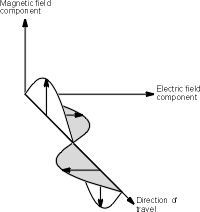Electromagnetic waves and antenna basics
- an overview, summary, tutorial about the basics of electromagnetic waves
and the way in which they affect RF antenna and RF antenna design.
Radio signals are a form of electromagnetic wave, and as they
are the way in which radio signals travel, they have a major bearing on RF
antennas themselves and RF antenna design. Electromagnetic waves are the same
type of radiation as light, ultra-violet and infra red rays, differing from them
in their wavelength and frequency. Electromagnetic waves have both electric and
magnetic components that are inseparable. The planes of these fields are at
right angles to one another and to the direction of motion of the wave.

An electromagnetic wave
The electric field results from the voltage changes occurring
in the RF antenna which is radiating the signal, and the magnetic changes result
from the current flow. It is also found that the lines of force in the electric
field run along the same axis as the RF antenna, but spreading out as they move
away from it. This electric field is measured in terms of the change of
potential over a given distance, e.g. volts per metre, and this is known as the
field strength. Similarly when an RF antenna receives a signal the magnetic
changes cause a current flow, and the electric field changes cause the voltage
changes on the antenna.
There are a number of properties of a wave. The first is its
wavelength. This is the distance between a point on one wave to the identical
point on the next. One of the most obvious points to choose is the peak as this
can be easily identified although any point is acceptable.

Wavelength of an electromagnetic wave
The wavelength of an electromagnetic wave
The second property of the electromagnetic wave is its
frequency. This is the number of times a particular point on the wave moves up
and down in a given time (normally a second). The unit of frequency is the Hertz
and it is equal to one cycle per second. This unit is named after the German
scientist who discovered radio waves. The frequencies used in radio are usually
very high. Accordingly the prefixes kilo, Mega, and Giga are often seen. 1 kHz
is 1000 Hz, 1 MHz is a million Hertz, and 1 GHz is a thousand million Hertz i.e.
1000 MHz. Originally the unit of frequency was not given a name and cycles per
second (c/s) were used. Some older books may show these units together with
their prefixes: kc/s; Mc/s etc. for higher frequencies.
The third major property of the wave is its velocity. Radio
waves travel at the same speed as light. For most practical purposes the speed
is taken to be 300 000 000 metres per second although a more exact value is 299
792 500 metres per second.
Frequency to Wavelength Conversion
Although wavelength was used as a measure for signals,
frequencies are used exclusively today. It is very easy to relate the frequency
and wavelength as they are linked by the speed of light as shown:
lambda = c / f
where lambda = the wavelength in metres
f = frequency in Hertz
c = speed of radio waves (light) taken as 300 000 000 metres per second for all
practical purposes.
Field measurements
It is also interesting to note that close to the RF antenna
there is also an inductive field the same as that in a transformer. This is not
part of the electromagnetic wave, but it can distort measurements close to the
antenna. It can also mean that transmitting antennas are more likely to cause
interference when they are close to other antennas or wiring that might have the
signal induced into it. For receiving antennas they are more susceptible to
interference if they are close to house wiring and the like. Fortunately this
inductive field falls away fairly rapidly and it is barely detectable at
distances beyond about two or three wavelengths from the RF antenna.

|

